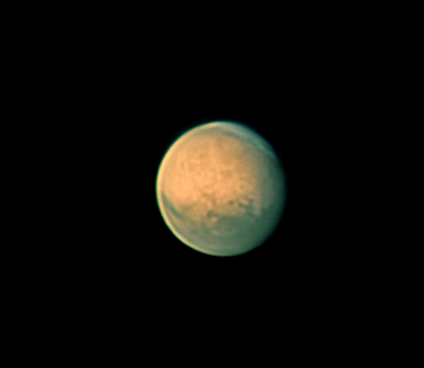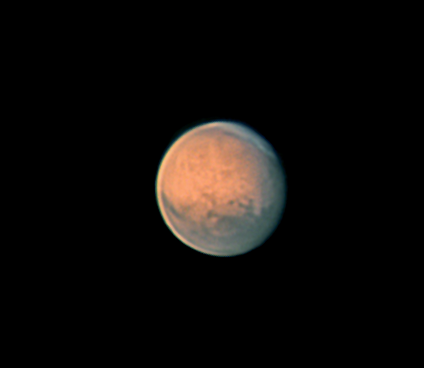-
Posts
3,766 -
Joined
-
Last visited
-
Days Won
15
Content Type
Profiles
Forums
Gallery
Events
Blogs
Posts posted by geoflewis
-
-
7 minutes ago, neil phillips said:
Look forward to seeing them Geof. I initially setup. but cloud came over as soon as i started the first capture ( dont you just love the UK ) I waited and it all cleared again. So my timestamp of the first usable capture was 02:04 UT
Ah, so much later. I went to bed at around 2am, but looked out first and it was still solid cloud here.
-
 1
1
-
-
Thee's been a lot of discussion about optimal sampling for planetary imaging recently, so last night I set out to do a comparison. Of course the conditions were far from ideal, with me having to dodge clouds or maybe increasing for. The seeing was average at best, but transparancy was variable, so not sure what if anything my testing reveals or proves (probably not much).
Here are two back to back images from 6 min SERs with no de-rotation. Each is best 20% and sharpened in Registax 6 using the default (not gaussian) wavelet filters. I tried my best to match the details, but that was challenging and for the F18 image introduced more noise without ever getting the same level of detail. I just could not reveal the subtle detailed swirls in the EZ and the dark and white spots towards the poles, just aren't as crisp in the F18 image.
NB Jupiter transitted the meridian at 20:30, so these were shortly after that.
F18 (timestamp = 20:42pm)

F11 (20:59pm)

Sorry, I don't know how to resize the images so that the two Jupiters are the same size, so happy for anyone else to do that or let me know how to do it.
What I can say, si that the file sizes imaging at F18 were huge (double) and AS3! on my G5 gaming laptop took for ever to process the F18 data (I thought it was going to die...!!)
Maybe in better seeing, I might get better results at F18, but currently I'm not seeing any benefit operating at the higher sampling rate; IMHO there's a lot more downside with the huge files created.
I will be very interested to hear what others think. I have some IR and CH4 images that I captured at both FLs, so will share those later.
-
 3
3
-
 1
1
-
-
Those are cracking good Mars images Neil. What time were you out there. I set up earlier to do some sampling testing on Jupiter, including my 1st try at CH4 imaging, but was fighting clouds. I did slew over to Mars later and grab some data, but it was shrouded in brightly illuminated fog and by 11pm I had pretty much total cloud cover so gave up. I haven't processed my dats yet, other than play with the CH4 Jups, so will post everything up later.
-
Good question. There is another thread on Affinity V2 here, so you may want to add to that rather than a separate thread. I'm hoping James Ritson will chime in on that thread as he's been specifically mentioned there.
-
 1
1
-
-
Those look pretty good to me considering the conditions you had. Lots of detail coming through and the colour balance looks excellent.
-
Lovely image Geoff
-
Looking good Chris. I haven’t been able to capture any Mars images since 31 October, so I’m beginning to get anxious when the conditions will break for me….. The forecast for tomorrow (Saturday) looks good, but 2 days ago that’s what the forecast indicated for tonight (Friday), but that’s all gone….
-
 1
1
-
-
That’s lovely, a very natural looking Mars.
-
 1
1
-
-
2 minutes ago, Magnum said:
You need to use around 100ms in methane as its a narrowband fikter
1 minute ago, Magnum said:Take 5 still frames then use them in registax or AS3 when you stack the avi,
Thanks Lee, I'll give CH4 imaging a bit more thought; it sounds pretty tricky to me.....🤔
-
1 minute ago, Kon said:
I was all clouded out to be see the event. I think you need to give your hygienist a list of upcoming celestial events to avoid booking you in 🤣.
It's an upcoming event on 8 Dec 2022, or are you also a time traveller....😉. Yes, I prefer pm appointments for reasons of potential astronomy related lie ins, but my wife booked this one.....🤷♂️
-
 1
1
-
-
13 minutes ago, Magnum said:
using gain this high causes a quite a bit of colour noise and hot pixels to show so they recommend taking a dark frame for stacking
How do you take a dark frame with this camera? I've never done any calibration frames for lunar or planetary, so really have no idea.....
-
7 minutes ago, Magnum said:
I can answer regarding settings for methane band. it's same as normal capture but is a very dark filter so need longer shutter speed and higher gain, also helps to use Lowe F ratio to get brighter image. if using 290 mono then you will need to bin 2x2, but the 462C is much more sensitive in that wavelength so doesn't need binning.
with the 12" scope I have to use about 100ms shutter speed with gain quite high about 475, using gain this high causes a quite a bit of colour noise and hot pixels to show so they recommend taking a dark frame for stacking. Chris go with his C14 says he does 12fps with similar gain.
Lee
Thanks Lee, this is very helpful. I did take a look with the CH4 filter and the ASI462, but all I got was a screen full of what looked like a noise, albeit Jupiter shaped, i.e. a speckled mess. I think was at 8ms, with the gain pushed all the way, so quickly gave up. Also, how do I set the RGB histograms for capture, is it the same as with colour, i.e. try to get them all equal, or doesn't it matter?
-
 1
1
-
-
30 minutes ago, Kon said:
I hope just a routine dentist appointment and not being in pain.
It was awful with jet stream over us last night, but the night before it was nice despite the wind. I hope you manage to get out soon.
It was just routine hygenist appointment, so has been rescheduled to 8 Dec, but I've just realised that's the morning after the lunar occultation of Mars, which starts around 5am, so probably I should be awake, though if it's been an all nighter I may fall asleep in the dentist chair.... I don't know what it is with my dentist and astonomy clashing.....🙄
-
25 minutes ago, Kon said:
Thanks Geoff. I will send you a private message later today to ask a few questions on capture settings and processing methane data, if that's ok.
I'll look out for that, but I can't help you with methane band imagin as I've never done that. I did just get a methane filter with the ASI462MC, but like you I have no idea where to start with it.....🤷♂️
-
17 minutes ago, Nigella Bryant said:
Many thanks geoflewis, there were a set of 9 two minute vids stacked image's that were de-rotated. As I'm new to planetary imaging I'm never sure how much to sharpen and colour balance. Plus didn't no about denoise in autostakker, lol. All a new learning curve from solar imaging, lol.
Thanks for the additional info. As you'll discover, how much to sharpen, denoise and what colour balance is something that will never leave you with planetary imaging (well that's my experience anyway). I think you did a great job with this first attempt, but you come from a great place with your stunning solar images.
-
 1
1
-
-
Some good detail coming through the IR, Lee
-
Really nice Jupiter Kon
-
 1
1
-
-
Really nice Mars images Kon. I’ve missed out recently, other than some amplification experiments with the new Baader barlow a couple of nights ago, but it was far too windy for me to get anything usable. I should have gone out last night, but I had a dentist appointment booked this morning, so didn’t want to be out late. Then I got a phone call first thing this morning saying that my appointment has to be postponed, as the dentists cat is unwell…..😠
-
 1
1
-
-
-
19 hours ago, Nigella Bryant said:
Wow Nigella, you’re on a roll with this planetary imaging; it’s an excellent Mars. FWIW, I slightly prefer the less red first version, but both are really good 👍
-
 1
1
-
-
Only just seen this Nigella and you’ve clearly taken to
On 08/11/2022 at 17:02, Nigella Bryant said:Hi Nigella, I’ve only just seen this thread and you’ve clearly got a handle on de-rotation pretty quickly. You got an excellent Jupiter already, especially if this is only your 2nd attempt. I prefer the 2nd of these 3 images as it’s the most natural looking, with loads of subtle detail showing. How many frames did you stack in each image before de-rotation, or did you de-rotate the video?
Lots of excellent advice here and as @neil phillips suggests, I too find that using the auto RGB balance in Registax does an excellent job. I will then use either PS, or AffinityPhoto to boost saturation / vibrancy.
-
 1
1
-
-
All 3 are superb images, I particularly like the Mars which is really starting to stretch its legs now.
-
Thanks @vlaiv, I’m am gradually beginning to understand this better - I think 🤔
-
11 hours ago, vlaiv said:
F/ratio = pixel_size * 2 / wavelength_of_light
Hi @vlaiv. I've been thinking about this formula a fair bit since we discussed sampling on my Jupiter thread the last couple of days. My understanding of Nyquist theorem (which is very limited) is that sampling must be 'at least' twice the frequncy of the anologue signal, so is there some wriggle room in using a number greater than 2? Would that contribute to why some planetary imagers are imaging at significantly longer focal lengths, i.e. what if we used 2.25, 2.5 or 3 in the above equation and what wouldn't we? If I use, say, px-size*3/wavelenght of light with my 2.9mn camera pixels, then I'd get 2.9*3*(1000/400)=21.75. So I guess I'm asking, why are we restricted to the *2 factor, it's a pretty crude component of the formula isn't it?






.jpg.08a45843e5e6ca1f047f8687b5ba3b5b.thumb.jpg.d4d722ec8ef6b10e329cf623810b1b3f.jpg)










Jupiter sampling C14 F11 vs F18 - 11 Nov 2022
in Imaging - Planetary
Posted
I think this whole topic is a crap shoot when imaging in the UK. The seeing is so changable, that it's almost impossible to get a reliable comparison.
I've just processed two IR images, one at F18 about an hour earlier than the F11 image and they're like night and day with the F18 image streets better.
IR - F18 (20:20pm)
IR - F11 (21:16pm)
I've tried to resize them to the same size. It's a complete reversal of what I saw with the RGB images.....🤷♂️
I know the seeing had deterioated a lot and I was imaging through passing cloud, but Iif I understand correctly, accoring to the maths, the longer wavelength of IR should perform better at lower sampling rates - I really don't know what to make of it and as @neil phillips commented on his recent Mars thread, I think we can get too hung up about it and should just go with whatever works for us.